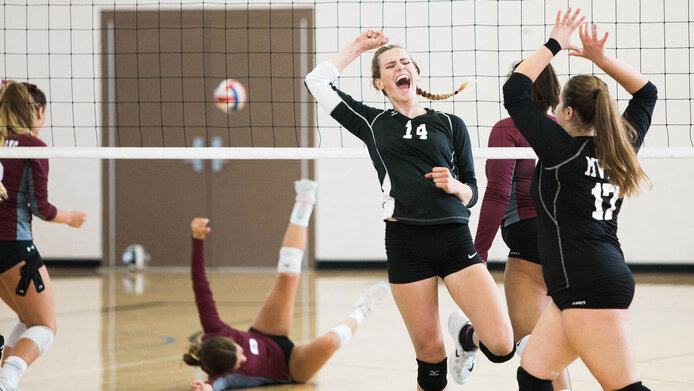Painless therapy for tendon disorders

Tendon disorders have often proved to have a painful impact on an athlete's career. They don’t even need an acute injury to develop. Incorrect or excessive loading can lead to problems in the long term. Typical disorders in this context are so-called tendinopathies (Latin tendo “tendon” and Greek pathos “disease”). These non-inflammatory tendinopathies may occur, for example, when someone changes their training style or habitual patterns of movement. Professional athletes are not the only ones at risk: over time, tendinopathy may even be caused by a running shoe that has been excessively used and worn out.
Tendinopathies are a research interest of Florian Rieder, who currently works in the field of physical medicine and rehabilitation at the University Hospital Salzburg. In the context of the recently completed FWF project “Good Vibrations” he has been studying, in recent years, diseases of the patellar tendon, which connects the kneecap to the tibial attachment on the lower leg. Patellar tendinopathies, a condition typically found in professional volleyball and basketball players, cause severe knee pain. What is more, the current standard therapy can also be extremely painful. For this reason, Rieder has explored the effectiveness of a more recent therapeutic approach, a form of vibration training, for treating these conditions.
Defective tissue rebuilding
“The patellar tendon is responsible for the transmission of force between the upper and lower leg. When tensed it stores energy which is released again when it is relieved of its load – comparable to a rubber band. And it acts as a shock absorber during jerky movements,” Rieder explains. Excessive loading can cause the tendon to degenerate. “The body's repair processes are interrupted, the tissue structure is faulty,” notes Rieder. Special strength training is a well-established therapeutic approach. Patients repeatedly perform slow movements with heavy weights. These loads ensure that the body resumes its own repair mechanisms. The approach is effective, but often very painful and therefore unsuitable for many people.
In his thesis at the University of Salzburg, which he completed in 2016, Rieder had already looked into vibration therapy. This approach involves positioning oneself on a vibrating plate that oscillates about 30 times per second. At that time, Rieder was able to describe the first effects on the patella tendons. “I was able to show that a rebuilding process was set in motion in healthy individuals. The tendon cross-section increased significantly,” Rieder explains. The FWF project, which Rieder conducts in cooperation with Hans-Peter Wiesinger from the Interfaculty Department of Sport Science and Kinesiology at the University of Salzburg, builds on the work done for his thesis. “It was a very interdisciplinary project in which researchers from the University of Salzburg and the University Hospital of Salzburg – especially from the fields of physical medicine and radiology – invested a lot of additional work,” says Rieder.
Study with 60 subjects
Similar to strength training, vibration therapy causes muscles to tense and relax, and tendons to be subjected to alternating tensile forces. The fundamental difference, however, lies in the intensity and frequency. “The question was, what effects we would be able to detect with this pain-free alternative,” Rieder says. The researchers recruited a total of about 60 subjects for the study, whom they divided into three groups: the patients in the first group were treated with vibration therapy three times a week for three months; the patients in the second group underwent strength training. Members of the third group, on the other hand, received no therapy at all. They served as control group that enabled a comparison with patients who had not received any treatment.
In a sideline study, the researchers first focused on the way in which a healthy tendon differs from a diseased one in mechanical terms. “The investigations showed that diseased tendons are significantly thickened in comparison with healthy ones. However, unlike healthy tendons that are trained, their stiffness does not increase in line with the cross-section. On the contrary, it even shows lower values,” Rieder explains. “This could increase the risk of injury.”
Direct comparison between therapies
Ultimately, the comparison of the training methods revealed that clinically relevant changes were seen in both the strength training and the vibration group. “The improvements concerned both maximum pain and functional impairments,” says Rieder. “In other words, the pain was less intense and the patients were able to move better again.” However, a direct comparison of the approaches also showed differences. “While both forms of therapy were able to achieve a similarly good reduction in maximum pain, conventional strength training was slightly more effective in treating functional limitations,” Rieder explains. In all cases, the therapies resulted in lasting success, as shown by a check-up after six months.
But even if the effectiveness of vibration therapy is slightly lower than that of strength training, Rieder sees the study as confirmation that it offers a good alternative in many cases. “There are patient groups for whom painful strength training is out of the question. These include athletes who can't fit in additional strength exercises while they are training, or older people who can't cope with the pain. For them, it's definitely a good idea to try vibration therapy.”
Personal details
Florian Rieder completed his doctoral studies in sports science at the University of Salzburg in 2016. In the following years, he worked both at the Interfaculty Department of Sport Science and Kinesiology at the University of Salzburg and at the Physical Medicine and Rehabilitation Unit at the University Hospital Salzburg. Since 2020, he has been working full time at the hospital as a sports scientist and training therapist. Rieder was the principal investigator of the project “Good Vibrations: Effectiveness of Vibration Training for the Treatment of Tendinopathy”, which was funded by the Austrian Science Fund FWF with EUR 270,000.
Publications
Wiesinger HP, Seynnes OR, Kösters A, Müller E, Rieder F: Mechanical and Material Tendon Properties in Patients With Proximal Patellar Tendinopathy, in: Frontiers in Physiology 2020
Wiesinger HP, Rieder F, Kösters A, Müller E, Seynnes OR: Sport-specific capacity to use elastic energy in the patellar and Achilles tendons of elite athletes, in: Frontiers in Physiology 2017
Rieder F, Wiesinger HP, Kösters A, Muller E, Seynnes OR: Whole-body vibration training induces hypertrophy of the human patellar tendon, in: Scandinavian Journal of Medicine and Science in Sports 2016
Rieder F, Wiesinger HP, Kösters A, Muller E, Seynnes OR: Immediate effects of whole body vibration on patellar tendon properties and knee extension torque, in: European Journal of Applied Physiology 2016





